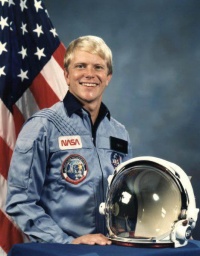George D. Nelson
From The Space Library
 George D. Nelson | |
| Birth Name | George D. Nelson |
|---|---|
| Birth Date | Jul 13 1950 |
| Occupation | NASA Astronaut (former), (Ph.D.) |
Contents |
[edit] Personal Data
Born July 13, 1950, in Charles City, Iowa. Considers Willmar, Minnesota, to be his hometown. His wife Susie is from Alhambra, California. They have two daughters. Pinky enjoys playing golf, reading, swimming, running, and music.
[edit] Education
Graduated from Willmar Senior High School, Willmar, Minnesota, in 1968; received a bachelor of science degree in Physics from Harvey Mudd College in 1972 and a master of science and a doctorate in Astronomy from the University of Washington in 1974 and 1978, respectively.
[edit] Experience
Dr. Nelson performed astronomical research at the Sacramento Peak Solar Observatory, Sunspot, New Mexico; the Astronomical Institute at Utrecht, Utrecht, the Netherlands, and the University of Gottingen Observatory, Gottingen, West Germany, and at the Joint Institute for Laboratory Astrophysics in Boulder, Colorado.
[edit] Spaceflight Experience
NASA EXPERIENCE: Dr. Nelson was selected as an astronaut candidate by NASA in January 1978. He flew as a scientific equipment operator in the WB 57-F earth resources aircraft; served as the Astronaut Office representative in the Space Shuttle Extravehicular Mobility Unit (space suit) development effort. During STS-1 he was the photographer in the prime chase plane. He also served as support crewman and CAPCOM for the last two OFT flights, STS-3 and STS-4, and as head of the Astronaut Office Mission Development Group. A verteran of three space flights, Dr. Nelson served aboard STS-41C in 1984, STS-61C in 1986 and STS-26 in 1988. He has logged a total of 411 hours in space, including 10 hours of EVA flight time. STS-41C Challenger (April 6-13, 1984) was a seven day mission during which the crew successfully deployed the Long Duration Exposure Facility (LDEF); retrieved the ailing Solar Maximum Satellite, repaired it on-board the Orbiter, and replaced it in orbit. The mission also included flight testing of Manned Maneuvering Units (MMUs) in two extravehicular activities (EVAs), and operation of the Cinema 360 and IMAX Camera Systems. STS-61C Columbia (January 12-18, 1986) launched from the Kennedy Space Center, Florida, and returned to a night landing at Edwards Air Force Base, California. During the six day flight the crew deployed the SATCOM KU satellite, and conducted experiments in astrophysics and materials processing. STS-26 Discovery (September 29 to October 3, 1988) was the first mission flown after the Challenger accident. During the four day flight, the crew successfully deployed the Tracking and Data Relay Satellite (TDRS-C), and operated eleven mid- deck science experiments.
[edit] Organizations
[edit] Special Honours
NASA Exceptional Engineering Achievement Medal, NASA Exceptional Service Medal, 3 NASA Space Flight Medals, AIAA Haley Space Flight Award, Federation Aeronautique Internationale's V. M. Komarov Diploma.
[edit] Other Information
Apr-89
